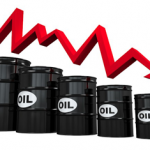HSBC reports on Oil prices scenarios

Despite hopes that lower oil prices will stabilise global growth, experience suggests otherwise. Growth was disappointing in 2015 even though the oil price had plunged in 2014.
While developed-world consumer spending grew at the fastest rate since before the financial crisis, global GDP growth was much weaker than had been expected.
The World Bank estimates that oil’s near-50 per cent fall in the second half of 2014 should have raised global GDP by 0.7 per cent in 2015. Instead, GDP growth slowed.
Given the markets’ reaction to sliding oil prices, one might think there are no winners. But in 2015 the clear beneficiary, accounting for more than 50 per cent of global GDP, was the western consumer. US households saved some of their windfalls, but the modest early forecasts for eurozone consumption – and those in some commodity-importing emerging markets – were beaten convincingly.
So what of 2016-17? Our central assumption is that oil prices will be roughly stable, perhaps slightly higher. But below we also examine the consequences of other scenarios: a demand-driven rise in oil prices, a price rise caused by a supply shock, and the impact of oil falling yet further.
If the output freeze agreed between Russia, Saudi Arabia and other oil producers in mid-February becomes a full-blown deal, for example, it would certainly support the price of crude.
But the main upside risk from low oil prices relates to consumers: households expecting prices to stay lower for longer and therefore starting to spend more of their windfall gains. However, even in developed countries, the growth risks from continued declines in oil prices and the policy challenges for central banks stem from the deflationary consequences.
Four oil price scenarios
- A roughly stable oil price allows robust real wage growth in developed markets to support consumer spending, but inflation remains well below target and investment is weak. US interest rates are slow to rise and rates elsewhere are cut, moving into increasingly negative territory. Commodity-producing countries reduce spending further and emerging-market nations’ growth outlook deteriorates.
- A demand-driven oil price rise would ease the fiscal and financial pressures on commodity-producing and emerging-market economies. The US probably continues raising rates and, if eurozone inflation heads rapidly towards 2 per cent, markets might expect the European Central Bank to taper its quantitative easing (QE) purchases, despite better export growth prospects – though market volatility could ensue if Japan maintains its policies.
- A supply shock that lifts oil sharply would ease the pressure on oil-producing economies’ currencies but the squeeze on real wages could curb western consumer spending. A cautious US Federal Reserve might hold rates or even cut them as growth falters. However, higher eurozone inflation and talk of tapering QE amid fiscal and political troubles could revive fears of a new eurozone crisis.
- A sustained drop below USD25 a barrel would produce an exaggerated version of our stable-price case, but strains on financial markets would intensify as global growth expectations keep falling. Contagion could spread to non-commodity emerging markets, weakening exchange rates and endangering foreign currency-denominated debt. The need for external assistance programmes would grow. Major central banks would ease policy, hopefully co-ordinating with each other, but the eurozone would struggle to reach policy consensus.

Source: HSBC





























